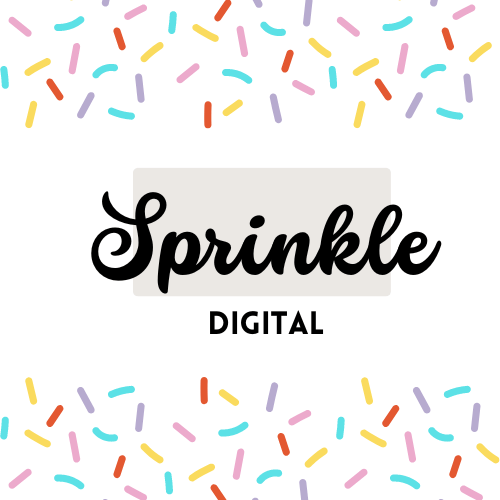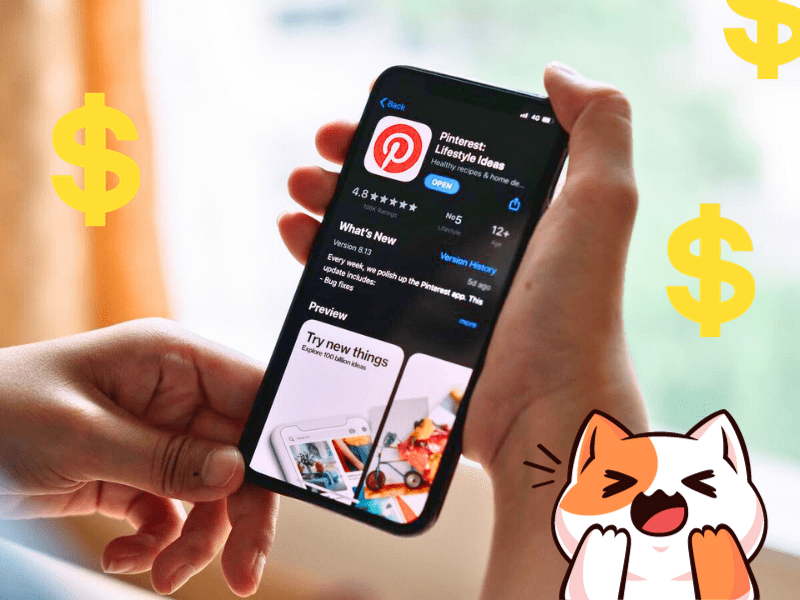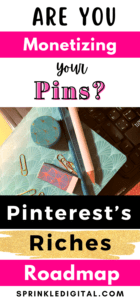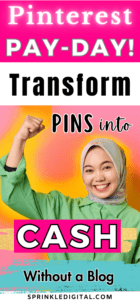Make Money on Pinterest
When you think of Pinterest you probably think of this obscure mysterious rabbit hole of interior design and teenage girl quotes. I get it. I used to think the same. The truth is Pinterest is so much more than that. Beyond being a source of inspiration Pinterest serves as a REAL goldmine for earning money. There are so many different niches. And with over 400 million active users each month- that’s an INSANE amount of free traffic to use to make money on Pinterest.
I mean would you say no to 400 million user-traffic? I don’t know any other social media platforms that you can use like this.
The awesome thing is you can make money on Pinterest even if you don’t have a blog.
You know how when you start a new website, it doesn’t show up well on Google? That’s called the “Google Sandbox.” It’s like an unconfirmed trial period where Google wants to trust that your site is legit. As your site gets older and better, it starts ranking higher in Google search results.
So even if you do have a blog and don’t want to be sluggish during the 6(ish) month period, you can follow this guide and sell on Pinterest without a blog. Here’s how to do it.
In this comprehensive guide I go over how to make money on Pinterest with or without a blog. I use method 2 (with a blog).
This post may contain affiliate links at no extra cost to you, I may earn a small commission. This allows me to keep this blog going and provides you with free content. All opinions are my own.
Pinterest is a platform primarily focused on visuals. Think Google With Images- where Users search for inspiring pins on their feeds and view pins that catch their attention.
Once they click on a pin they will be redirected to anywhere you want. By creating graphics and images related to your blog content you can capture the attention of Pinterest users and lead them towards your blog or to buy your product.
Make Money on Pinterest WITHOUT a Blog
Even if you don’t have a blog to link to you can still use affiliate marketing on Pinterest by linking your affiliate pins to the products or services you’re promoting.
By linking your affiliate pins directly to the product’s landing page, you eliminate the need for a blog or website as an intermediary. Users who click on your affiliate pin will be taken straight to the product, where they can make a purchase!
Remember to disclose that your pin contains affiliate links if required by the policies of the affiliate program or local regulations.
Here’s the full breakdown:
• Choose Affiliate Products with Direct Landing Pages: When you join an affiliate program, look for products or services that have direct landing pages. These pages are specifically provided by the affiliate program to promote the product. They usually contain a description, images and a “Buy button.
• Join Pinterest: Now that you’ve written the content- use Pinterest to promote these blogposts! Set up a Pinterest Business account to promote your blog. If you’re serious about making money on Pinterest it’s important to have a Pinterest Business account. It’s free.
• Create Engaging Boards: Organize your pins into boards. Each board should have a specific theme or topic. Ensure your boards are visually appealing, and don’t forget to add descriptions.
• Create pins: Use tools like Canva to create pins. Ensure that the pin clearly showcases the product you’re promoting and includes a call to action.
Make sure the pin clearly showcases the product you’re promoting and includes a compelling call-to-action.
• Write a Descriptive Pin Description: Write engaging descriptions for your pins that provide information about the product and encourage users to click on the pin. Use relevant keywords to make it discoverable.
• Add Your Affiliate Link: Pin affiliate products to your relevant boards. When you do this- make sure to use your affiliate link.
When you create the pin, you’ll have the option to add a destination link. Paste your affiliate link here. This link will take users directly to the product’s landing page.
The best part? Whenever someone makes a purchase through your link you earn a commission. Include a clear and concise call to action (CTA) in the pin description, encouraging users to click on the link to learn more or make a purchase. Disclose that you are using affiliate links. You can do this by writing something like “This pin contains affiliate links.”
• Pin It to Relevant Boards: Pin your affiliate pin to Pinterest boards that are related to the product or your niche. This will help it reach a targeted audience.
Pros of Making Money on Pinterest Without a Blog
- Using Pinterest to make money can be quicker and more hands-off than having a blog
- Pinterest is free
Cons of Making Money on Pinterest Without a Blog
- Alot of people don’t usually make a purchase directly through a random link. Before that they’ll listen to someone’s recommendations and their experience with the product. This is where having a blog can be essential.
- You don’t have a close audience. Without a blog, you don’t really have a close audience nor subscribers who relate to you. You also don’t have an email list you can use to promote to them. With a blog, you can build an email list and then target your readers- they’ll be more likely to listen to your recommendations.
- You’re entirely dependent on Pinterest’s policies and algorithms. You’re eggs are all in one basket. This can negatively affect your income and makes you vulnerable if Pinterest decides to make changes to it’s platform. You also don’t own your content on Pinterest. Whereas, with a blog you do.
Keep reading below to find out more about how to make money with a blog.
Make Money on Pinterest WITH a Blog
Here’s a breakdown of how you can make money on Pinterest WITH a blog:
• Start your own blog today! I really recommend Hostinger as a hosting service – I personally use it for my blog. It’s great because it includes WordPress, allowing you to create a professional-looking site starting for as little as $2.99 per month.
That’s like a Starbucks coffee (even less). To get started, check out ‘How to Start an Anonymous Blog and Make Money‘
• Select Your Blogging Niche: First select a niche that interests you, whether it’s food, travel, fashion, or something else.
Related: Selecting your Blogging Niche + Worst Niches to Avoid
• Create and Monetize Content: Write blog posts on your blog and earn from them through ads, affiliate products, or sponsored placements.
• Join Pinterest: Now that you’ve written the content- use Pinterest to promote these blogposts! Set up a Pinterest Business account to promote your blog. If you want to make money seriously on Pinterest, make sure to set up a Pinterest Business account. It’s free.
Related: Why You Need a Pinterest Business Account + Quick Setup
• Create Engaging Boards: Organize your pins into boards. Each board should have a specific theme or topic. Ensure your boards are visually appealing, and don’t forget to add descriptions.
• Design Pins: Design bomb pins for your blog post.
• Maximize your Pins with SEO: Use Pinterest SEO to make sure your pins and board are optimized and will reach a maximum audience.
• Share on Pinterest: Post these pins on Pinterest to reach a wider audience. When people click your pin they will be redirected to your blogpost or to your affiliate link or product. Ka’ching!
So now that you figured out how to use Pinterest to make money what the heck should you promote?
What to Sell on Pinterest to Make Money
Here are some examples of products you can sell on Pinterest without a blog.
Sidenote: you can also sell these directly on your blog as well with your own storefront (on your blog).
Just remember one thing: choose products that align with your niche and target audience on Pinterest. It’s crucial to pick items you have knowledge and are passionate about. By doing you’ll be able to create content that feels genuine and makes people want to read it.
1. Handmade Crafts and Art:
If you’re skilled in crafting and love creating items like jewelry, home decor or artwork you can sell your creations on Etsy (a popular marketplace for DIY’ers) or set up your online store to showcase your creations. You can then link to your Pinterest pin.
2. Fashion and Accessories:
Interested in fashion? You can sell clothing, shoes, handbags or accessories either through affiliate marketing programs or by setting up your online store. Create fashion boards on Pinterest and pin stylish outfits and accessories.
3. Home Decor and Furniture:
If interior design is your thing, why not consider selling home decor items, furniture pieces or vintage finds? Show off your design skills by pinning images of your products in styled home settings.
Share design inspiration with others, by pinning images of your products in styled home settings.
4. Beauty and Skincare Products:
Partner with Sephora or Ulta through affiliate programs to promote beauty and skincare items, or explore opportunities to create your beauty-focused store.
Pin images of skincare routines, makeup tutorials, or product reviews with affiliate links to the recommended products.
5. Health and Wellness Products:
Market health and wellness products like vitamins, supplements or fitness equipment. Create boards related to healthy living, workout routines, or wellness tips and link to relevant products.
Use Amazon Associates to link to a wide range of health and wellness products, or set up your own online store specializing in wellness items.
6. Cooking and Kitchen Products:
Discover and share yummy recipes, cooking tips and kitchen gadget reviews on Pinterest. Include affiliate links that direct users towards recommended cooking appliances, utensils, or ingredients on Amazon Associates or create your online shop to cater to cooking enthusiasts.
7. Travel Accessories and Gear:
If you have a passion for travel, promote travel-related products like luggage, travel accessories, or travel clothing. Create boards with travel inspiration and link to products you’ve used and recommend.
You can use Amazon Associates to feature travel gear or create a dedicated online store for travel-related products on your blog.
8. Tech Gadgets and Accessories:
Recommend tech gadgets and accessories through Amazon Associates.
Pin images of the latest tech gadgets, smartphones, or accessories. Provide product reviews and comparisons to help users make informed purchasing decisions.
9. Books and E-books:
Share book recommendations and create boards. Use affiliate links to direct users to purchase books from online bookstores or e-books from platforms like Amazon Kindle.
10. Subscription Boxes:
Ever thought about promoting subscription box services? They’re great for niches like beauty, wellness, fashion or gourmet foods. Create engaging pins that highlight the value of subscribing.
You can directly promote specific subscription box services or use their affiliate programs to earn commissions for referrals.
11. Handmade Personalized Gifts:
If you’re skilled in personalizing gifts like custom-made jewelry or engraved products, showcase your creations on Pinterest and link to your online Etsy store or your own online store.
12. Printable Products:
Get creative with products! Design things like planners, calendars, art prints or educational resources that people can print at home.
Pin images of your printable sand link them to Esty or whichever e-commerce platform you use.
13. Digital Products and Courses:
Share your expertise by creating and selling digital products like e-books, online courses, or templates in your area of expertise on platforms like Teachable, Udemy, or your online course platform.
14. Pet Products and Accessories:
Cater to pet owners by promoting pet-related products such as pet accessories, toys, or grooming supplies on Amazon Associates. Share cute pet photos and tips for pet care.
15. Vintage and Collectible Items:
If you have access to vintage or collectible items promote them on Pinterest. Curate pins that highlight their history and value.
Use eBay for a broad audience interested in vintage and collectibles or opt for Etsy to reach collectors and enthusiasts in a unique marketplace.
Remember to optimize your product listings and pins with relevant keywords, attractive images, and compelling descriptions to maximize your sales potential on Pinterest.
Important Things to Consider:
Here are some crucial points to remember when it comes to Affiliate marketing on Pinterest.
• Check Affiliate Link Permissions: Some companies may not permit the use of their affiliate links on Pinterest. It’s essential to check this on their company website.
• Use Original Images: It’s important to note that some companies, such, as Amazon have restrictions on using their website images for pins even if you’re an affiliate.
• Link Transparency: Pinterest encourages maintaining transparency when it comes to affiliate links and discourages masking or shortening them.
• Disclosure is a Must: To comply with FTC regulations, always disclose your affiliate relationship. A simple way to do this is by adding #affiliate or #affiliatelink in your pin description.
Takeaway
Now that you have a guide on how to make money on Pinterest, it’s time to take action. Whether you have a blog or not, Pinterest can be GAME-CHANGER in your online income journey when used correctly.
By following these steps and staying committed to your niche, you can use Pinterest’s massive user base to earn BIG.
Found this guide on How to Make Money on Pinterest helpful? Pin it now and read it again later
Save or Share!



